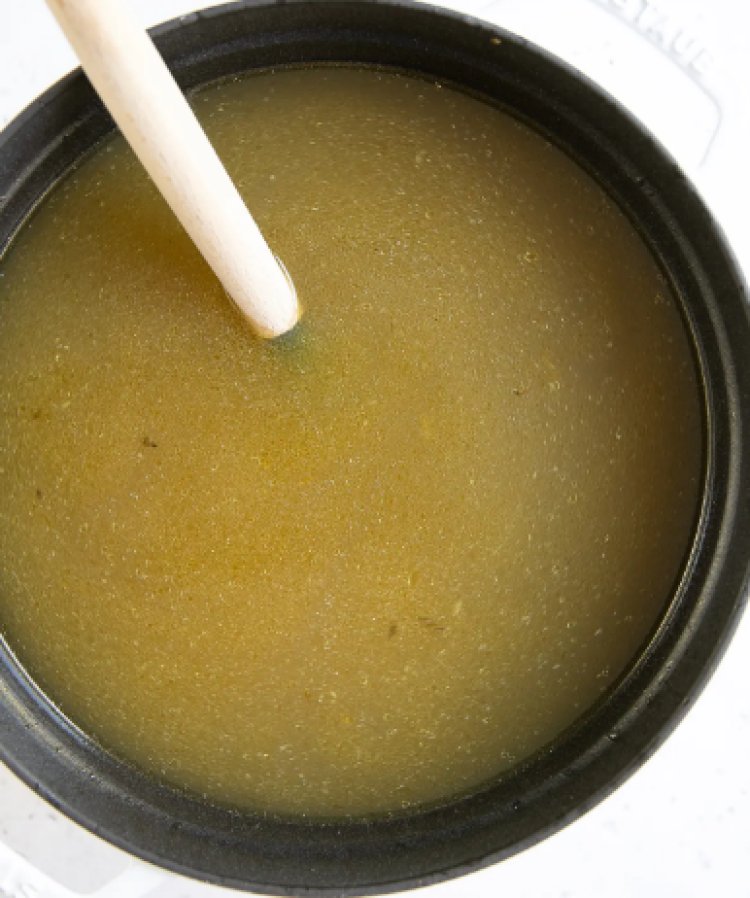Rich Homemade Chicken Stock Recipe
Chicken stock is quite easy to prepare and you need a few simple ingredients such as bones, fresh herbs, and vegetable pieces.

Chicken bones are boiled in water for at least 4-6 hours to create chicken stock. You may serve chicken stock with all of your favorite soups, stews, or rice dishes because it is delicious and versatile.
What is the difference between chicken stock and chicken broth?
The bony parts of the chicken are always used to make chicken stock. For increased flavor, meat, vegetables, and herbs are occasionally included. On the other hand, chicken broth is created using meat, never bones, and simmers for much less time. Since gelatin is present, chicken stock is thicker and more flavorful than chicken broth, which is lighter and better suited for use as a soup base or general cooking liquid.
How long to store chicken broth in a refrigerator or freezer
You must first cool chicken stock to room temperature before storing it in the freezer or refrigerator. The simplest and quickest way to do this is to place your pot in your sink's ice water bath.
After it has cooled, you can either put the pot in the refrigerator and consume the stock within 5 days, or you can divide it up into containers of varying sizes. The chicken stock can then be kept in freezer bags or glass jars. Chicken stock can be kept in the freezer for up to 6–9 months or in the refrigerator for up to 5 days.

Ingredients
1 whole chicken
1-pound chicken feet or chicken necks (optional)
2 medium yellow onions, quartered
3 large carrots, chopped
3 ribs celery - chopped into pieces
1 head garlic - unpeeled and cut in half crosswise
1 small bunch of fresh parsley
2 sprigs of fresh rosemary
3 bay leaves
8 sprigs of fresh thyme
10 leaves of fresh sage
1 tablespoon salt - plus more to taste
1 tablespoon black peppercorns
Procedure

Set the oven to 450 degrees and stuff the chicken with shredded vegetables.
Place the breast-side-up of your chicken in a sizable roasting pan and put in the oven and bake for 30 minutes.
After 30 minutes of roasting in the oven, carefully flip the chicken over and bake the other side for an additional 15 to 30 minutes.
Put the chicken in a large stockpot with the vegetables. Scrape any particles that could be stuck to the roasting pan, then add them to the pot.
Add the fresh parsley, rosemary, bay leaves, thyme, sage, salt, and black peppercorns to your pot. Fill your pot with cold water so that your chicken and vegetables are completely submerged.
Place on the stovetop with the lid on tightly, and the heat should be high. Bring to a gentle boil, then immediately lower heat to a simmer, leaving the lid slightly ajar, and occasionally scraping off any froth or extra fat.
After approximately one hour, remove the chicken from the saucepan and set aside to cool on a baking sheet. Once it is cold enough use your fingers to remove the meat from the bones, reserving the meat to use for soup, sandwiches, or salads, and the bones to place back in the pot to continue cooking.
Carefully drain your cooked stock through a cheesecloth or fine mesh strainer. Add a few handfuls of ice to speed up the cooling process and bring the stock to room temperature, which is ideal for storing.
Take some of the fat out of your stock, but not all of it. Leave a little fat since it adds taste. However, place your pot in the refrigerator and let it cool completely if you want to skim some of the fat off. The outcome will be a thick coating of firm fat on top. Scoop out as much fat as you'd like using a fork or spoon.
Serve your stock or store if required.

Conclusion
Chicken stock is so rich and nutrient-dense, it's a simple way to give all of your favorite stews a flavor boost. When cooking rice, beans, couscous, quinoa, dumplings, and even mashed potatoes, you may use homemade chicken stock in place of water or as the base for soups and stews.

























